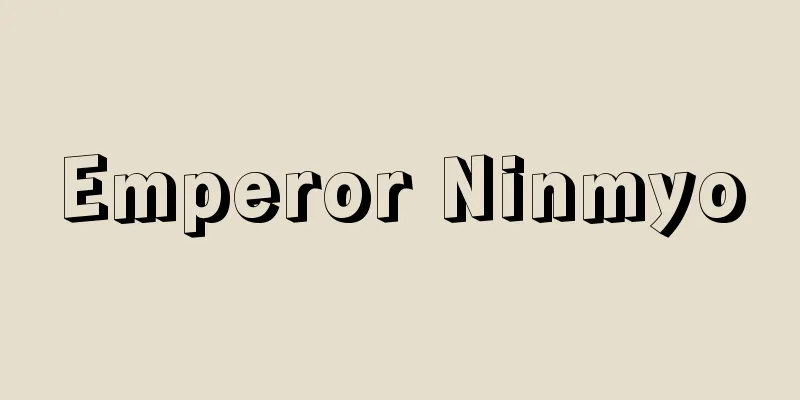Emperor Ninmyo

|
Year of death: Kasho 3.3.21 (850.5.6) Year of birth: 810 Emperor of the early Heian period. Son of Emperor Saga and Empress Tachibana Kachiko (daughter of Kiyotomo). Given name Masayoshi. Also known as Emperor Fukakusa. In 823 (Kōnin 14), he was made crown prince at the age of 14, and ascended to the throne in 833 (Tenchō 10). Prince Junna's son Prince Tsunesada was made crown prince, but due to the Jowa Incident (842), Michiyasu (later Emperor Montoku), son of Fujiwara Fuyutsugu's daughter Junko, was made crown prince instead. He loved learning, and read the theories of Laozi and Zhuangzi, as well as the Gunsho Chiyō, and was said to have been so familiar with Chinese pronunciation that he could distinguish between clear and voiced sounds. He was also known for his many talents, and was skilled in archery, drumming, koto, and flute playing, and it is said that he learned Emperor Junna's cursive calligraphy to the point that he could not distinguish between the two. He was born with a weak constitution and was well versed in medicine, and it is said that no renowned physician could disagree with him when it came to compounding his medicines. To avoid criticism, he passed away after having the medicines he compounded acknowledged as not being the cause of his death. He died in Seiryoden, his residence during his lifetime, but the following year it was dismantled by his son, Emperor Montoku, and rebuilt next to his tomb (Fukakusa, Fushimi Ward, Kyoto City), and named Kashodo after the era of the time. This was the first time that a Seiryoden was rebuilt during the Heian period. (Takinami Sadako) Source: Asahi Japanese Historical Biography: Asahi Shimbun Publications Inc. About Asahi Japanese Historical Biography |
|
没年:嘉祥3.3.21(850.5.6) 生年:弘仁1(810) 平安前期の天皇。嵯峨天皇と皇后橘嘉智子(清友の娘)の子。諱は正良。深草天皇とも。弘仁14(823)年,14歳で立太子,天長10(833)年即位し,淳和皇子恒貞親王を皇太子としたが,承和の変(842)により,藤原冬嗣の娘順子との間に生まれた道康(のちの文徳天皇)がかわって皇太子とされた。学問を好み,老荘の説や『群書治要』などを通覧,ことに漢音では清音と濁音が区別できるほど精通していたという。また多芸で知られ,弓射をはじめ鼓琴吹管をよくし,書も淳和天皇の草書を学んで両者の区別がつかないほどであったと伝える。生来病弱なこともあって医学にも詳しく,薬の調合に至ってはいかなる名医も異論を立てられなかったといい,また非難をさけるために,調合した薬が死因でないことを認めさせたうえで没している。生前居所とした清涼殿で亡くなったが,翌年子の文徳天皇によって解体,陵(京都市伏見区深草)のかたわらに移建され,時の年号をとって嘉祥堂と呼ばれた。これは平安期における清涼殿建て替えの初例。 (瀧浪貞子) 出典 朝日日本歴史人物事典:(株)朝日新聞出版朝日日本歴史人物事典について 情報 |
Recommend
Seifu Ginkyoku (The Lady of the Warriors' Song)
A long poem in Chinese written at the end of the L...
Banten (English spelling) banteng
It is a mammalian animal of the order Artiodactyl...
Ryogoku Bridge
This bridge connects Higashi-Nihonbashi in Chuo W...
Southeast Asian Movies - Tounan Asia Movies
The umbrella concept and term "Southeast Asia...
Ibigawa River
Along with the Kiso River and Nagara River in the...
Image sensor - image sensor
Image sensor. A general term for devices (semicond...
The opening of the rocks - Isonokuchiake
The practice of restricting the harvesting of seaw...
Kienholz, E.
…Junk art, which mainly uses waste from industria...
Oyacho - Ooyachi
…The city area was also the base of the Ise Taira...
Ujigami Shrine - Ujigami Shrine
Located in Ujiyamada, Uji City, Kyoto Prefecture....
《Osan Mohee》 - Osan Mohee
...A domestic drama. Commonly known as "Osan...
Yellow-naked kanoko - Yellow-naked kanoko
Please visit the "Kanokogata" page. Sou...
Keynesian revolution
The influence of J.M. Keynes's work, The Gene...
Afonso Henriques
…reigned 1139-85. Also called Afonso Henriques. B...
Flying squirrel - Momonga
A general term for animals in the Pteromys genus ...









